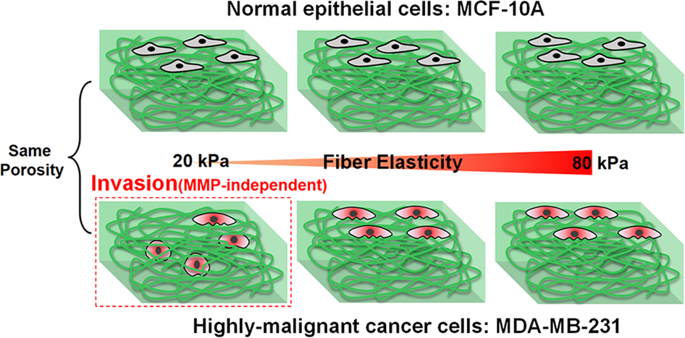Our official English website, www.x-mol.net, welcomes your
feedback! (Note: you will need to create a separate account there.)
Characterization of 3D matrix conditions for cancer cell migration with elasticity/porosity-independent tunable microfiber gels
Polymer Journal ( IF 2.3 ) Pub Date : 2019-10-30 , DOI: 10.1038/s41428-019-0283-3 Daoxiang Huang , Yu Nakamura , Aya Ogata , Satoru Kidoaki
Polymer Journal ( IF 2.3 ) Pub Date : 2019-10-30 , DOI: 10.1038/s41428-019-0283-3 Daoxiang Huang , Yu Nakamura , Aya Ogata , Satoru Kidoaki

|
The mechanics and architectures of the extracellular matrix (ECM) critically influence 3D cell migration processes, such as cancer cell invasion and metastasis. Understanding the roles of mechanical and structural factors in the ECM could provide an essential basis for cancer treatment. However, it is generally difficult to independently characterize these roles due to the coupled changes in these factors in conventional ECM model systems. In this study, to solve this problem, we developed elasticity/porosity-tunable electrospun fibrous gel matrices composed of photocrosslinked gelatinous microfibers (nanometer-scale-crosslinked chemical gels) with well-regulated bonding (tens-of-micron-scale fiber-bonded gels). This system enables independent modulation of microscopic fiber elasticity and matrix porosity, i.e., the mechanical and structural conditions of the ECM. The elasticity of fibers was tuned with photocrosslinking conditions. The porosity was regulated by changing the degree of interfiber bonding. The influences of these factors of the fibrous gel matrix on the motility of MDA-MB-231 tumorigenic cells and MCF-10A nontumorigenic cells were quantitatively investigated. MDA-MB-231 cells showed the highest degree of MMP-independent invasion into the matrix composed of fibers with a Young’s modulus of 20 kPa and a low degree of interfiber bonding, while MCF-10A cells did not show invasive behavior under the same matrix conditions. To understand the roles of mechanical and structural factors in the extracellular matrix on cancer cell migration, elasticity/porosity-tunable gel matrices of gelatinous microfibers were developed. The elasticity of fibers and the porosity of matrix were tuned with photocrosslinking conditions and degree of interfiber bonding, respectively. Highly malignant MDA-MB-231 cells showed the highest degree of MMP-independent invasion into the matrix composed of fibers with a Young’s modulus of 20 kPa and a low degree of interfiber bonding, while nontumorigenic MCF-10A cells did not show invasive behavior under the same matrix conditions.
中文翻译:

用弹性/孔隙率无关的可调微纤维凝胶表征癌细胞迁移的 3D 基质条件
细胞外基质 (ECM) 的力学和结构严重影响 3D 细胞迁移过程,例如癌细胞侵袭和转移。了解机械和结构因素在 ECM 中的作用可为癌症治疗提供重要基础。然而,由于传统 ECM 模型系统中这些因素的耦合变化,通常很难独立表征这些角色。在这项研究中,为了解决这个问题,我们开发了弹性/孔隙率可调的电纺纤维凝胶基质,由光交联凝胶微纤维(纳米级交联化学凝胶)组成,具有良好的键合(数十微米级纤维键合)凝胶)。该系统能够独立调节微观纤维弹性和基质孔隙度,即,ECM 的机械和结构条件。纤维的弹性通过光交联条件进行调节。通过改变纤维间结合的程度来调节孔隙率。定量研究了纤维凝胶基质的这些因素对 MDA-MB-231 致瘤细胞和 MCF-10A 非致瘤细胞的运动性的影响。MDA-MB-231 细胞对由杨氏模量为 20 kPa 的纤维组成的基质表现出最高程度的 MMP 独立侵袭,纤维间结合程度较低,而 MCF-10A 细胞在同一基质下没有表现出侵袭行为使适应。为了了解细胞外基质中机械和结构因素对癌细胞迁移的作用,开发了凝胶状微纤维的弹性/孔隙率可调凝胶基质。纤维的弹性和基质的孔隙率分别通过光交联条件和纤维间结合程度进行调节。高度恶性的 MDA-MB-231 细胞对由杨氏模量为 20 kPa 的纤维组成的基质表现出最高程度的 MMP 非依赖性侵袭,纤维间结合程度较低,而非致瘤性 MCF-10A 细胞在相同的矩阵条件。
更新日期:2019-10-30
中文翻译:

用弹性/孔隙率无关的可调微纤维凝胶表征癌细胞迁移的 3D 基质条件
细胞外基质 (ECM) 的力学和结构严重影响 3D 细胞迁移过程,例如癌细胞侵袭和转移。了解机械和结构因素在 ECM 中的作用可为癌症治疗提供重要基础。然而,由于传统 ECM 模型系统中这些因素的耦合变化,通常很难独立表征这些角色。在这项研究中,为了解决这个问题,我们开发了弹性/孔隙率可调的电纺纤维凝胶基质,由光交联凝胶微纤维(纳米级交联化学凝胶)组成,具有良好的键合(数十微米级纤维键合)凝胶)。该系统能够独立调节微观纤维弹性和基质孔隙度,即,ECM 的机械和结构条件。纤维的弹性通过光交联条件进行调节。通过改变纤维间结合的程度来调节孔隙率。定量研究了纤维凝胶基质的这些因素对 MDA-MB-231 致瘤细胞和 MCF-10A 非致瘤细胞的运动性的影响。MDA-MB-231 细胞对由杨氏模量为 20 kPa 的纤维组成的基质表现出最高程度的 MMP 独立侵袭,纤维间结合程度较低,而 MCF-10A 细胞在同一基质下没有表现出侵袭行为使适应。为了了解细胞外基质中机械和结构因素对癌细胞迁移的作用,开发了凝胶状微纤维的弹性/孔隙率可调凝胶基质。纤维的弹性和基质的孔隙率分别通过光交联条件和纤维间结合程度进行调节。高度恶性的 MDA-MB-231 细胞对由杨氏模量为 20 kPa 的纤维组成的基质表现出最高程度的 MMP 非依赖性侵袭,纤维间结合程度较低,而非致瘤性 MCF-10A 细胞在相同的矩阵条件。











































 京公网安备 11010802027423号
京公网安备 11010802027423号